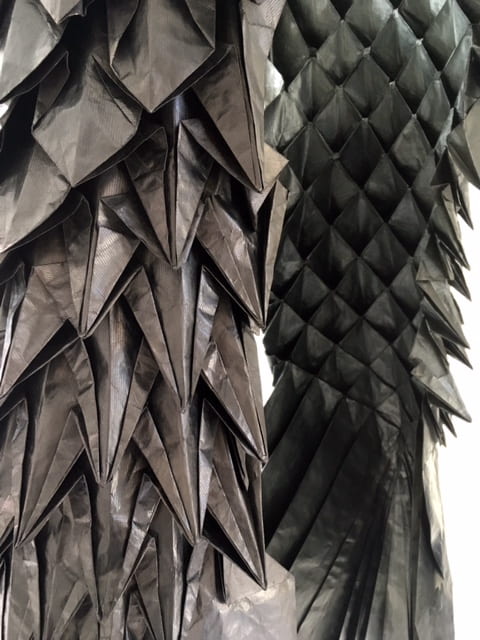Yohji Yamamoto’s exhibition in Israel opens today.

Unfortunately I am unable to go but it brings to mind the great honour I had to be invited to be the guest speaker at the dinner in honour of Yohji Yamamoto and the wonderful exhibition at the V&A covering 40 years of his career, curated so brilliantly by Ligaya Salazar.
There are a number of reasons why this was such an honour. Here is the speech I made on the night.
After Dinner Speech in Honour of Yohji Yamamoto at Victoria and Albert Museum
“As you may be aware the London College of Fashion and the V&A has had a close relationship sharing for example joint research fellows or collaborating on projects such as that based on the recent Ballet Russe show. But above all we share a commitment to look at ways that fashion is represented, discussed and challenged and this exhibition is a great example. For this show clearly demonstrates how one individual has explored all the possibilities inherent in an industry such as fashion, so epitomising Henry Cole’s founding principle to make works available to all, to educate working people and to inspire British designers and manufacturers- Yohji Yamamoto since he burst onto the Paris fashion stage in the 1980s has inspired not only British fashion designers but artists and designers world wide.
 Image: Elle Hank
Image: Elle Hank
This brings me to the other reason why tonight is such an honour- Yohji Yamamoto himself. For those of you who know me, you know that I am a dedicated follower of his approach to fashion. Not only buying too many of his pieces but studying how and why he creates in the way that he does trying to understand how he has managed to make us change fundamentally how we think about clothes.
He is often described as being a designers’ designer but for me that still underplays the significance of his approach, in a nutshell I believe it is because Yohji is an artist who just happens to express himself through the medium of fashion.
Like all great artists he combines a number of concepts and turns them on their head. When I think about how his approach to fashion relates to other revolutionary artists, I think of Zaha Hadid – fashion like architecture is about volume, shape and engineering- without it the clothes won’t hang together or adequately cover the body. Like Rothco he is able to make you think about block colour in a completely different way with his infinite shades of black, which he uses so unnecessary meaning or emotion isn’t added to the clothes. Like Beckett Yohji has challenged the established language of fashion by filtering out unnecessary elements or embellishments so he forces us to think about how and why clothes express aspects of our gender, body shape and personality,. The result is that Yohji’s clothes move beyond fashion they push our ideas about what clothes are to the edge – like all great art they have a heritage and link to the past but they also unequivocally point to the future and new ways of seeing clothes.
I believe there are a number of reasons as to why Yohji has been so significant. On one level it is because as he has himself has said, the technique comes later. First one must be struck by something beautiful, then appreciation of shape, volume, takes effect and then how to arrange the fabric and whether to use darts and hems follows.
Although he describes his clothes as being without nationality and they are timeless original pieces, it is his Japanese heritage where involvement with western clothing has only been for a 100 years, I feel enables Yohji and other Japanese designers to approach western clothing in a completely new and original way- he is not hide bound by our conventions and so has developed a new language based on deconstructing masculine tailoring and relating that to the female form.
 Yellow strapless silk dress and oversized coolie hat covered with draped silk, Yohji Yamamoto, Spring/Summer 1997
Yellow strapless silk dress and oversized coolie hat covered with draped silk, Yohji Yamamoto, Spring/Summer 1997
Similarly any visit to Japan reveals the quality and originality of Japanese textiles. From the outset, Yohji has worked with Japan’s craft textiles, supporting local small-scale producers. For fabric is central to his work and his deep interest in textiles and the significance of fabric shines through every collection- something you have all witnessed tonight when viewing this show. Throughout his career he shows a perfect understanding of fabric and its ability to embody a garment, give strength to a fragile frame, shape the wearer and indeed how it speaks.
His belief is that perfection is ugly, that it is scars, failure, disorder act rather as the grit does in the oyster, by helping to drive creativity and originality. The result is freedom from convention and timeless fashion you can still wear his pieces 5 or 10 years later. They are in a way in direct opposition to the fashion industry for as Wim Wenders the German film director describes it- the clothes are new, but when you put them on you feel as though you have been wearing them for years, they are like a second skin.
Emeritus Professor of General Linguistics at Oxford Roy Harris makes clear, that the arts are interrelated in certain specific ways, and none is independent of the other and Yohji has consistently demonstrated this by collaborating across disciplines. One of the most interesting aspects of this exhibition is how it makes this so clear. From designing costumes for opera’s such as Madame Butterfly or Tristan und Isolde, to films such as Dolls or Zaitoichi, each of his collaborations have been carefully chosen to complement his work- whether Elton John, Pina Bausch, Peter Saville or the photographer Nick Knight Yohji is always generously open to the creative possibilities of collaboration- ‘my narrower world became so wide” is how he has described the effects on his practice. But it is his effect on us that we are honouring tonight. This exhibition captures in so many ways his enormous contribution to fashion, film, music and literature. He has made us think differently about clothes, what it means to wear them and their effect and relationship to all art forms and creative disciplines.
 Long red coat with netting, long black gathered dress with front pockets and black mesh top, Yohji Yamamoto, Autumn/Winter 1995-96
Long red coat with netting, long black gathered dress with front pockets and black mesh top, Yohji Yamamoto, Autumn/Winter 1995-96
An exhibition such as this is a significant reflection of the work of the V&A and all its staff. Dedicated to an international artist/designer it brings to new audiences work that many would not necessarily be aware of. Its creative displays integrate many of Yohji’s pieces into the established collections through the use of installation thereby encouraging visitors to reflect on the historic collections in a new light. It draws connections between history, the present and the possible futures something central to the development of culture and new artforms. It will also inspire new artists, designers, students and school pupils to reconceptualise how they see the world and how they will develop their practice. At a time when institutions such as the V and A are coming under great pressure it is wonderful to have the support of everyone here tonight, because without it innovative exhibitions such as this would not be possible.
So I would like to thank Yohji, the V&A to you all – its invaluable supporters.”


